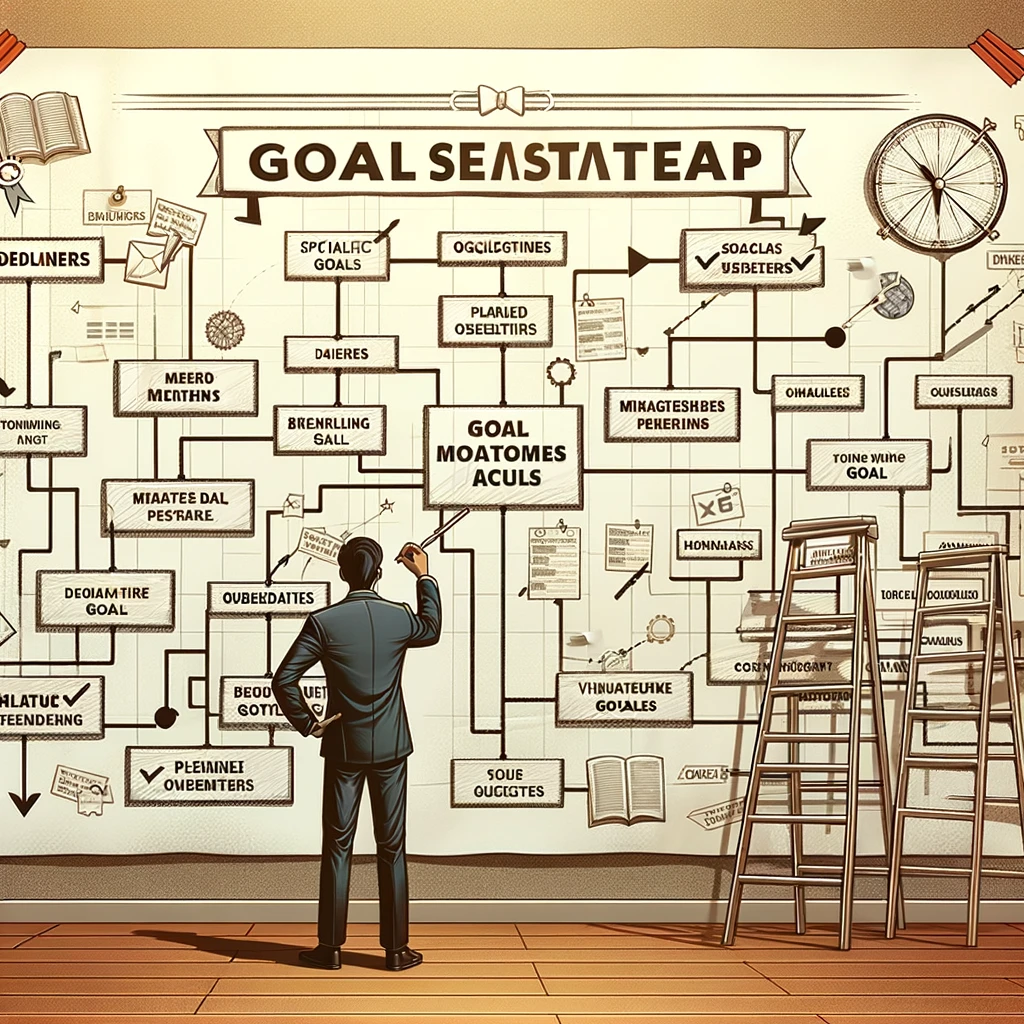Page Contents
- Introduction
- 1. Understanding the Limitations of Conventional Goal-Setting Methods like SMART Goals
- 2. Embracing a Dynamic Approach: Introducing the Key Principles of Dynamic Goal Frameworks for Entrepreneurs
- 3. Strategy #1: Cultivating Clarity Through Outcome Visualization and Strategic Planning
- 4. Strategy #2: Embracing Flexibility and Learning from Setbacks
- 5. Strategy #3: Leveraging Technology for Accountability and Measurement
- Conclusion
- FAQs (Frequently Asked Questions)
- What is the importance of goal setting for entrepreneurs with busy schedules?
- What are the common challenges that busy entrepreneurs face when it comes to setting and achieving their goals?
- What will the article cover in terms of practical and effective goal setting strategies for entrepreneurs?
- How can readers explore more resources on goal setting and entrepreneurship?
- Why may conventional goal-setting methods like SMART goals not always work effectively for entrepreneurs?
- Why do entrepreneurs need to adopt a more flexible and adaptive approach towards goal setting?
Introduction
As the heart of entrepreneurial success, goal setting is a strategic process that involves defining clear, measurable objectives and outlining the necessary steps to achieve them. Goal setting for entrepreneurs is particularly crucial as it provides them with a sense of direction and purpose, aligns their efforts with business priorities, and fuels their motivation amidst challenging circumstances.
However, busy entrepreneurs often grapple with multiple challenges in their goal-setting journey. These may include lack of time for strategic planning, difficulty in maintaining focus amidst pressing daily tasks, or struggle with adapting goals in response to rapidly changing market conditions.
In this article, we will delve into five practical and effective goal-setting strategies tailored for busy entrepreneurs. These strategies transcend the traditional SMART approach to help you set flexible and dynamic goals that cater to both your immediate business needs and long-term financial aspirations.
By embracing these strategies, such as learning how to stay committed to your online business, you can navigate your path towards financial freedom more effectively, making every step count in your entrepreneurial journey. You’ll learn how to balance risk management with profit goals, leverage visualization techniques for clarity, embrace flexibility in the face of setbacks, and harness technology for accountability and measurement.
1. Understanding the Limitations of Conventional Goal-Setting Methods like SMART Goals
Defining themselves as creators, problem solvers, risk takers, and visionaries, entrepreneurs are a unique breed. Their journey is filled with uncertainties and fluctuating market trends that demand a robust approach to goal-setting. This is where the conventional SMART system may fall short.
Renowned for its practicality, the SMART (Specific, Measurable, Achievable, Relevant, Time-bound) criteria has been a popular choice among many for setting goals. Its straightforward approach allows individuals to create clear and realistic objectives. However, in the entrepreneurial sphere, the rigidity of this method can be limiting. The dynamism and unpredictability inherent in entrepreneurship often require flexibility that surpasses SMART’s structured confines.

A common pitfall for entrepreneurs is an excessive focus on short-term profit goals. While immediate financial gain is enticing, it may lead to overlooking significant factors vital for long-term sustainability – such as customer satisfaction or employee engagement. This narrow-minded perspective can eventually hinder growth and scalability of the business.
Balancing financial objectives with risk prevention strategies in goal setting is crucial. Entrepreneurs must consider potential challenges and devise plans not only to mitigate risks but also to leverage them for future opportunities. This balanced approach ensures a sustainable growth trajectory that considers all facets of their business.
As we delve deeper into this topic, we’ll discover how entrepreneurs can go beyond traditional goal-setting methods to drive their businesses towards success while managing risks effectively.
2. Embracing a Dynamic Approach: Introducing the Key Principles of Dynamic Goal Frameworks for Entrepreneurs
Entrepreneurship inherently involves navigating an unpredictable landscape. The rigid structure of conventional goal-setting methods may not provide the needed flexibility. This necessitates adopting an approach that’s adaptable to shifting market dynamics and internal resource constraints.
Introducing, Dynamic Goal Frameworks; a concept designed to infuse agility into your entrepreneurial journey. Unlike traditional methods, these frameworks are not confined by stringent rules but are shaped by evolving business landscapes. They foster innovation, promote customer-centricity, and optimize resource utilization, thereby acting as catalysts for sustainable growth.
A dynamic goal framework encompasses several key elements:
Prioritizing Revenue Diversification
It’s critical to avoid placing all your eggs in one basket. A diversified revenue model offers multiple income streams, safeguarding businesses against market volatility and economic downturns.
Nurturing Long-term Customer Relationships
Businesses thrive on loyal customers. Invest time in building meaningful relationships with your clientele; this contributes to customer retention and drives consistent revenue.
Efficient Resource Management
Successful entrepreneurs know the importance of resource optimization. Whether it’s manpower or capital investment, effective deployment of resources can significantly influence business outcomes.

By integrating these principles into your goal-setting process, you can create a robust framework that evolves with your business needs and objectives. For insights into wealth building models that align with this dynamic approach, consider exploring Sakkemoto’s online resources. These models will help you achieve financial freedom by providing valuable insights on best practices for building financial wealth.
3. Strategy #1: Cultivating Clarity Through Outcome Visualization and Strategic Planning
Entrepreneurs often find themselves overwhelmed with daily tasks and deadlines, losing sight of their long-term goals. It’s crucial to regain clarity, and one effective way to do this is through visualization techniques. Take a moment to imagine your end goal—what does success look like? By creating a clear mental picture of these outcomes, you can find the motivation to take action and stay focused amidst the chaos.
Once you have a clear destination in mind, it’s important to establish a review process that keeps you on track. Regular check-ins allow you to:
- Track your progress
- Identify any hidden challenges
- Make adjustments to your strategies as needed
These assessments are key in turning your aspirations into tangible results, ensuring that you stay proactive and adaptable in the ever-changing world of entrepreneurship.
The next step is to create an action plan that outlines the specific steps you need to take towards your goals. This plan should:
- Break down your objectives into smaller, manageable tasks
- Anticipate any potential obstacles that may arise
- Have backup plans in place for unexpected situations
goal setting for entrepreneurs
By building flexibility into your plan, you’ll be able to pivot quickly when necessary and keep moving forward even in the face of setbacks.
Time management is a crucial skill for any busy entrepreneur. Here are some tactics to help you prioritize activities that align with your goals:

- Group similar tasks together to minimize distractions
- Make use of productivity tools for better organization
- Set aside dedicated time slots for focused work
If you’re looking for more insights on maximizing your time effectively, I highly recommend reading this informative article on Time is money! The Techniques To Maximize Time! at Sakkemoto. It provides valuable strategies that can help streamline your schedule and boost your productivity.
By following these strategies, entrepreneurs can navigate their journey with greater confidence and a clearer vision of what they want to achieve.
4. Strategy #2: Embracing Flexibility and Learning from Setbacks
Entrepreneurship is a journey filled with unpredictable twists and turns. Not every venture or idea will take off as planned, but these setbacks should not be viewed as failures – rather, they provide invaluable learning opportunities. This second strategy is centered on the practice of failure acceptance. By reframing so-called failures as stepping stones towards ultimate success, entrepreneurs can continuously learn, iterate, and improve their strategies.
The Power of Learning from Setbacks
Each setback brings you one step closer to identifying what truly works for your business. Here’s why embracing flexibility and learning from setbacks is crucial:
- Continuous Improvement: Viewing setbacks as learning opportunities allows you to constantly improve your approach and make necessary adjustments.
- Adaptability: Being flexible in your thinking enables you to adapt to changing market conditions and customer needs.
- Resilience: Embracing setbacks helps build resilience, allowing you to bounce back stronger from challenges.
Documenting Progress: A Key Motivator
A successful entrepreneurial journey lies in documenting progress consistently. Far from a mere tracking exercise, this process provides a clear visual representation of your achievements and challenges along the way. It serves as motivation to keep pushing forward and a reminder to celebrate each milestone, however small.
Remember: It’s often the small steps that lead to giant leaps.
Here are some ways you can document your progress:
- Keep a journal or logbook where you record your daily activities, wins, and lessons learned.
- Create visual charts or graphs to track key metrics or goals.
- Use project management tools or apps to organize tasks and monitor progress.
Staying Motivated with Rewards
Incorporating a rewards program or incentive system into your goal-setting strategy can also play a significant role in maintaining momentum. When specific milestones are met, rewarding yourself not only validates your efforts but also injects an element of fun into the process. This helps to keep you motivated and focused on achieving your long-term objectives.
Consider these ideas for rewarding yourself:
- Treat yourself to a favorite meal or activity.
- Take a break and indulge in a hobby or leisure time.
- Allocate extra funds for personal development or learning opportunities.
Remember, the key is to choose rewards that align with your values and provide genuine enjoyment.
Embracing Flexibility: A Path to Success
By adopting this flexible approach to goal setting – embracing setbacks as learning opportunities, documenting progress, and rewarding achievements – entrepreneurs can steadily navigate their path to success even amid challenges.
For instance, another aspect that contributes to success is achieving a healthy work-life balance. Employers and employees alike can benefit from implementing certain strategies that foster happiness and well-being in their professional lives. This article provides practical tips for achieving work-life balance and increasing happiness in the workplace – something that complements the entrepreneurial journey quite well.
5. Strategy #3: Leveraging Technology for Accountability and Measurement
In the pursuit of business success, technology becomes a crucial tool for busy entrepreneurs. It empowers them to set goals effectively by providing tools to visualize data, automate progress tracking, and promote teamwork.
How Technology Supports Goal Setting
Technology offers various benefits in the goal setting process:
- Visualization of Tasks and Timelines: Tools like Trello, Asana, or Slack help in mapping out tasks and project schedules visually. These platforms give a quick overview of ongoing projects, enhancing goal clarity and keeping everyone informed.
- Learning from Successful Entrepreneurs: Notable entrepreneurs like Elon Musk and Jeff Bezos have successfully utilized technology in their goal setting processes. They leverage advanced data analytics and cutting-edge tech infrastructure to track and measure progress towards their objectives.
- Alignment with Business Needs: Choosing the right digital platforms that align with specific business requirements is crucial. For example, if the goal is to increase social media engagement, tools like Hootsuite can automate posts and track performance metrics.
- Insights through Data Visualization: Tools such as Tableau can transform complex data into easy-to-understand visuals, providing insights into progress made towards goals.
- Efficiency through Automation: Automating routine tasks like progress tracking and report generation using project management tools enhances efficiency and frees up time for strategic decision-making.
- Team Collaboration: Platforms like Google Workspace or Microsoft Teams foster collaboration within teams, ensuring everyone is working towards the same business objectives.
The Role of Technology in Goal Review
Incorporating these tips into the goal review process will streamline operations and ensure prompt action plan implementation. Tech-enabled goal setting not only boosts accountability but also provides measurable metrics for success.
While choosing the right platform might seem overwhelming due to the numerous options available, exploring Morpher could be a good starting point. This platform offers 24/7 trading with zero fees, potentially providing a solution for entrepreneurs looking to diversify their revenue streams as part of their goals.

Remember, utilizing technology effectively can make the path to your goals clear, measurable, and achievable.
Conclusion
Busy entrepreneurs, let’s take a moment to reflect. Goal setting strategies are not a one-size-fits-all process. Embrace an approach that combines the best of traditional methods and dynamic strategies. Remember, the key is to visualize, plan, adapt, learn, and leverage technology.
The five strategies we’ve explored here can guide you on your path to success:

- Understanding the limitations of conventional goal-setting methods like SMART goals
- Embracing a dynamic approach with flexible goal frameworks
- Cultivating clarity through outcome visualization and strategic planning
- Embracing flexibility and learning from setbacks
- Leveraging technology for accountability and measurement
These strategies are designed to inspire you to set meaningful goals, stay focused amidst the bustle of entrepreneurial life, adapt to changing circumstances, learn from challenges, and harness technology to keep track of your progress.
As you embark on this journey towards financial freedom, remember that sakkemoto.com is your go-to hub for resources on goal setting and entrepreneurship. You can explore how to make money on the internet, get inspired by great ideas for a free startup, or dive deeper into when your website becomes a money machine.
Let these strategies be your compass. Let them empower you to chart your course towards financial freedom confidently. After all, as an entrepreneur, your success is not just about achieving financial milestones but also about mastering the art of effective goal management.
FAQs (Frequently Asked Questions)
What is the importance of goal setting for entrepreneurs with busy schedules?
Goal setting is crucial for the success of entrepreneurs, particularly those with busy schedules, as it helps them stay focused, prioritize tasks, and make progress towards their long-term objectives amidst their demanding routines.
What are the common challenges that busy entrepreneurs face when it comes to setting and achieving their goals?
Busy entrepreneurs often struggle with finding time for strategic planning, balancing short-term profit goals with long-term business growth, and managing external market dynamics and internal resource constraints effectively.
What will the article cover in terms of practical and effective goal setting strategies for entrepreneurs?
The article will share 5 practical and effective goal setting strategies that go beyond the traditional SMART approach. These strategies are designed to help entrepreneurs attain financial freedom in their businesses by addressing the limitations of conventional methods and embracing a dynamic approach to goal setting.
How can readers explore more resources on goal setting and entrepreneurship?
Readers can check out sakkemoto.com, the free hub to explore more resources on goal setting and entrepreneurship, to empower their journey towards financial freedom through effective goal management.
Why may conventional goal-setting methods like SMART goals not always work effectively for entrepreneurs?
Conventional goal-setting methods may not always work effectively for entrepreneurs because they may overly focus on short-term profit goals, which can hinder long-term business growth. Additionally, these methods may not adequately address the need for balancing financial objectives with risk management strategies in the entrepreneurial context.
Why do entrepreneurs need to adopt a more flexible and adaptive approach towards goal setting?
Entrepreneurs need to adopt a more flexible and adaptive approach towards goal setting in order to take into account external market dynamics and internal resource constraints. This approach allows them to drive innovation, foster customer-centricity, and leverage available resources effectively.
achieving financial goals financial freedom goals marketing money self improvement
Last modified: 5 April 2024









I was recommended this website by my cousin I am not sure whether this post is written by him as…